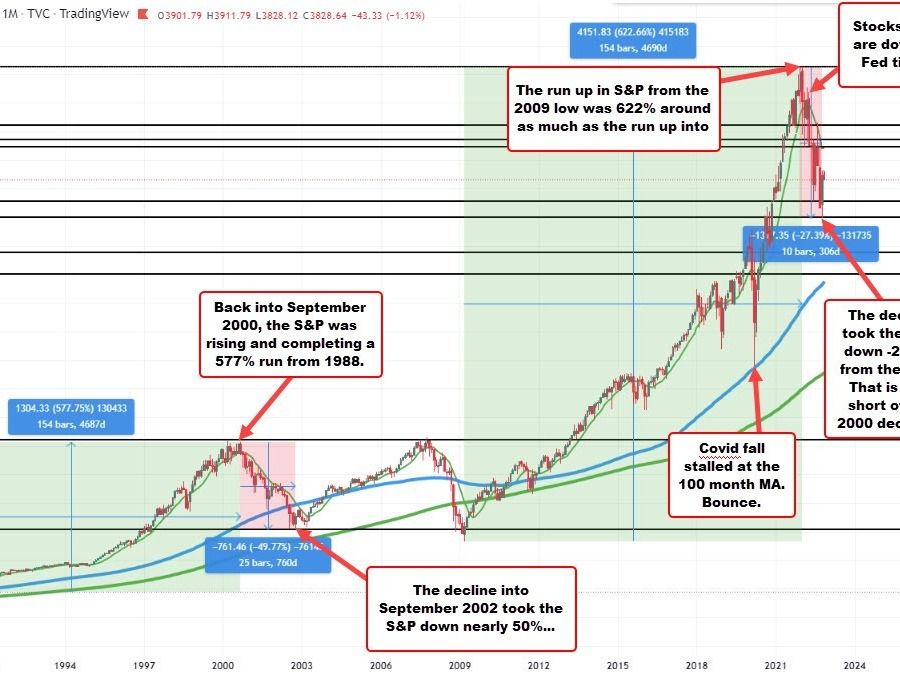S&P on the monthly chart
There are a lot of traders, and analyst who think that because the Fed is near the destination for rates, that the Pavlov reaction should be to “buy stocks baby”. It’s “green grass and high tides forever”.
That may be a short term idea, but I am not so sure it is sustainable.
Looking back to the bull run partly from the dot com 2000 boom for the S&P, the index moved higher and higher from 1988 to 2000. Over that time, the S&P moved up 577% into September 2000 when the retest of the earlier 2000 high was reached and the price then rotated down. That rotation saw the S&P lose close to 50% of the move higher. Yikes.
The last major bottom was in March 2009 and to the high reached at the end of 2021, the S&P price moved up 622% – about the same of the move up to the 2000 high.
The price decline off the high largely as a result of the Fed’s tightening and higher inflation, took the index down about 27.4%. The price is off the lows in anticipation that the end of tightening is near, inflation will come down, and that will lead to run up in stocks.
The 27.4% is a significant decline, but there was a pretty good run up from March 2009 to November 2021.In between, there was one big correction off March Covid lockdown, that saw the price move all the way down to test the 100 month MA, where buyers leaned and that led to the Covid rebound.
All dips from that low were bought. If there was even a modest dip, the Fed or government would come to the rescue. Rates were at 0%. Inflation was steadily below 2% target.
Needless to say that is NOT the case NOW. The Fed has doubled up to catch up from runaway inflation. Even though the market is calling for the end of inflation, in the last central tendencies the Fed still saw headline and core inflation at 2.3% inflation in 2024. In 2023 they see 2.8% for headline PCE and 3.1% for core in 2023. I wonder if that is higher now? It may be.
Yes the Fed may pause to see what happens, but it is just a pause, and it does not have to lead to a “too the moon rally in stocks”.
So in 2000, what was the Fed doing?
From December 1998 to September 2000, the Fed was raising rates (see green area in the chart below) . During that hike cycle, stocks moved higher into the September 2000 S&P high. Ironicaly, when the Fed then started to lower rates over the next 2 years (see red area in the chart below), stock prices moved lower with the decline in the Fed Funds rate. They did not go higher as people now expect with an unchanged policy for an extended period of time (best case).
Fed effective rate monthly
Yes, in 2000 it was the Dot Com bubble that burst and that was a bid deal, but the current environment may not be the dot.com bubble bursting, but is instead the end of free money/the end of Covid issues/the end of low inflation. Those things – like the dot com bubble – are big black swan things.
The point is, just because rates might stop going up, does not mean it is “green grass, and high tides forever” again. Just because we are closer to the destination, does not mean we are out of the dark tunnel and into the sunshine.
I will be watching the stock market technicals for clues (see daily chart below) for clues.
This week, the S&P moved up to test the 100 day MA and 50% of the last trend move lower from the August high (not the November 2021 high, the August 2022 high). The test failed near 3900. The S&P is currently at 3830.91.
That 100 day MA/50% retracement needs to be broken, and stay broken (it is just below 3900) to tilt the bias to the upside. Absent that, and even with steady rates because the “destination is reached or will be reached soon”, stocks can STILL go down. After all in 2000 to 2002, the Fed was easing and stocks went down too. They went down close to 50% before bottoming and moving back higher.
S&P stalled at 50% of August move lower and 100 day MA

 This “NEW CONCEPT” Trading Strategy Prints Money!… (INSANE Results!)
This “NEW CONCEPT” Trading Strategy Prints Money!… (INSANE Results!) RULE-BASED Pocket Option Strategy That Actually Works | Live Trading
RULE-BASED Pocket Option Strategy That Actually Works | Live Trading